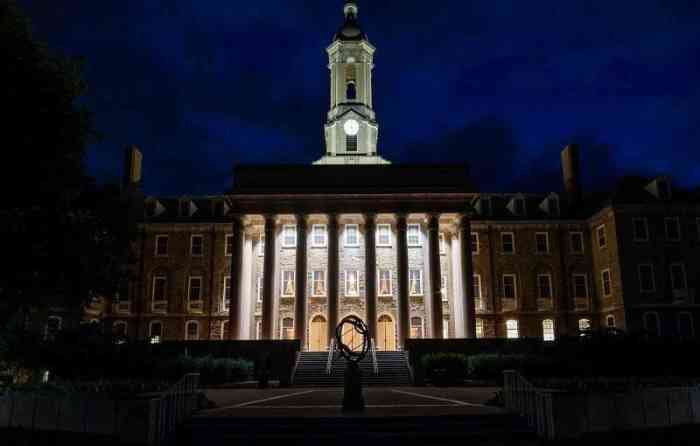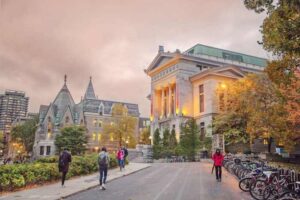Embark on a captivating journey to uncover the whereabouts of the esteemed University of Penn State. This comprehensive guide will take you on a virtual tour, exploring the university’s sprawling campuses and immersing you in their rich history and vibrant surroundings.
From the iconic University Park campus to its satellite locations, we’ll delve into the factors that shaped their establishment and the impact they have on the communities they call home. Join us as we unravel the geographical tapestry of Penn State, unlocking its hidden gems and revealing the reasons why it remains a beacon of higher education.
Location of University Park Campus
The University Park campus of Penn State University is situated in the heart of Pennsylvania, a state renowned for its picturesque landscapes and rich history. The campus is nestled within the charming town of State College, located in Centre County.
The complete physical address of the campus is:
University Park, PA 16802For a visual representation of the campus location, please refer to the embedded Google Maps link:
Branch Campuses and Their Locations
Penn State University has a comprehensive network of branch campuses spread across Pennsylvania. These campuses provide students with access to a wide range of academic programs and offer a convenient and flexible learning experience closer to their homes.
The branch campuses are strategically located in various regions of the state, ensuring that students have access to higher education regardless of their geographical location.
Branch Campus Locations
The following table provides a comprehensive list of Penn State’s branch campuses, along with their respective locations and distances from the University Park campus:
| Campus Name | Location | Distance from University Park |
|---|---|---|
| Altoona | Altoona, Blair County | 95 miles |
| Beaver | Monaca, Beaver County | 25 miles |
| Berks | Spring Township, Berks County | 60 miles |
| Brandywine | Media, Delaware County | 110 miles |
| DuBois | DuBois, Clearfield County | 120 miles |
| Erie, The Behrend College | Erie, Erie County | 140 miles |
| Fayette, The Eberly Campus | Lemont Furnace, Fayette County | 75 miles |
| Great Valley | Malvern, Chester County | 100 miles |
| Harrisburg | Middletown, Dauphin County | 90 miles |
| Hazleton | Hazleton, Luzerne County | 115 miles |
| Hershey | Hershey, Dauphin County | 95 miles |
| Lehigh Valley | Center Valley, Lehigh County | 70 miles |
| Mont Alto | Mont Alto, Franklin County | 105 miles |
| New Kensington | New Kensington, Westmoreland County | 30 miles |
| Scranton | Dunmore, Lackawanna County | 145 miles |
| Shenango | Sharon, Mercer County | 70 miles |
| Wilkes-Barre | Lehman, Luzerne County | 120 miles |
| Worthington Scranton | Dunmore, Lackawanna County | 145 miles |
| York | York, York County | 100 miles |
Historical Significance of Campus Location

The University Park campus of Penn State was founded in 1855 as the Farmers’ High School of Pennsylvania. The school was initially located in Centre County, Pennsylvania, due to its central location within the state and its proximity to agricultural resources. In 1863, the school was renamed the Agricultural College of Pennsylvania and became a land-grant university under the Morrill Act. In 1874, the school was renamed Pennsylvania State College, and in 1953, it was renamed The Pennsylvania State University.
The University Park campus is located in a rural setting, which has been a key factor in its development. The campus has been able to expand over time, and it now covers more than 7,000 acres. The campus is home to a variety of academic buildings, research facilities, and student housing. It is also home to the Penn State Arboretum, which is a 360-acre park that is open to the public.
Founding and Early Days of the Campus
The founding of the University Park campus was a major event in the history of Pennsylvania. The school was one of the first land-grant universities in the United States, and it played a key role in the development of agricultural education in the country. The campus was also a major center of research, and it helped to establish Pennsylvania as a leader in scientific and technological innovation.
The early days of the University Park campus were marked by rapid growth and development. The school’s enrollment grew from just a few dozen students in 1855 to more than 1,000 students by the end of the 19th century. The campus also saw the construction of a number of new buildings, including Old Main, which is the oldest building on campus.
Proximity to Major Cities and Transportation Hubs

The University Park campus is conveniently located within proximity to several major cities and transportation hubs, providing students and visitors with easy access to urban amenities and travel options.
The following table provides an overview of the distances and travel times from the University Park campus to major cities in the region, along with available transportation options:
Distances and Travel Times to Major Cities
| City | Distance (miles) | Transportation Options |
|---|---|---|
| Philadelphia | 230 | Amtrak, Greyhound, Megabus, driving |
| Pittsburgh | 150 | Amtrak, Greyhound, driving |
| Harrisburg | 80 | Amtrak, Greyhound, driving |
In addition to these major cities, the University Park campus is also located within a short driving distance of several smaller cities and towns, including State College, Bellefonte, and Altoona. These nearby communities offer a variety of shopping, dining, and entertainment options.
Surrounding Area and Amenities

The University Park campus is situated in a picturesque valley surrounded by rolling hills and lush greenery. The nearby towns of State College and Bellefonte offer a range of attractions, amenities, and cultural experiences.
The university’s presence has a significant impact on the local economy, providing employment opportunities and supporting businesses in various sectors. The university also plays a vital role in the community, hosting events, offering educational programs, and contributing to the area’s cultural landscape.
Nearby Towns
State College, located adjacent to the campus, is a vibrant town with a bustling downtown area featuring numerous restaurants, cafes, shops, and entertainment venues. Bellefonte, a historic town just a few miles away, offers a charming atmosphere with quaint shops, art galleries, and museums.
Attractions and Amenities
The surrounding area boasts an array of attractions, including the Arboretum at Penn State, a sprawling botanical garden showcasing diverse plant life. The Palmer Museum of Art houses a renowned collection of American and European art. For outdoor enthusiasts, the area offers hiking trails, biking paths, and scenic parks.
Cultural Institutions
The university’s Center for the Performing Arts presents a wide range of performances, from Broadway shows to classical music concerts. The Penn State University Libraries system is one of the largest academic research library systems in the United States, providing access to a vast collection of resources.
Restaurants and Shopping
State College is home to a diverse culinary scene, with restaurants serving everything from American comfort food to international cuisine. The town also features several shopping centers, including the Nittany Mall and the State College Marketplace, offering a wide variety of retail options.
FAQ Guide
Is the University of Penn State a public or private university?
The University of Penn State is a public, land-grant research university.
How many branch campuses does Penn State have?
Penn State has 19 branch campuses located throughout Pennsylvania.
What is the largest campus of Penn State University?
The University Park campus is the largest campus of Penn State University, with over 46,000 students.
Is the University of Penn State a good school?
Yes, the University of Penn State is a highly respected and well-ranked university. It is consistently ranked among the top 100 universities in the United States.




